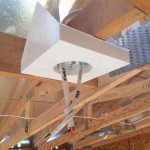How To Patch Ceiling Cracks
Ceiling cracks, while unsightly, are a common issue in many homes. The good news is that they can usually be patched up quickly and easily with a few basic tools and materials. Here are the steps on how to patch ceiling cracks:
Identifying the Cause of Ceiling Cracks
Before you start patching up ceiling cracks, it's important to identify what caused them in the first place. Some common causes of ceiling cracks include:
- Structural damage: This is the most serious type of ceiling crack and can be caused by things like foundation problems or roof damage. If you suspect that your ceiling cracks are caused by structural damage, it's important to get them checked out by a professional as soon as possible.
- Natural settling: As homes age, they naturally settle and shift, which can cause ceiling cracks. These cracks are usually small and don't pose any structural problems.
- Temperature changes: When the temperature in your home fluctuates, it can cause the ceiling to expand and contract, which can lead to cracks.
- Water damage: If your ceiling has been exposed to water damage, it can cause the drywall to swell and crack.
Tools and Materials You'll Need
Once you've identified the cause of the ceiling cracks, you can gather the tools and materials you'll need to patch them up. Here's a list of what you'll need:
- Putty knife
- Joint compound
- Sandpaper
- Primer
- Paint
- Caulking gun
- Caulk
Preparing the Ceiling
Before you start patching up the ceiling cracks, you need to prepare the surface. Here's how:
- Remove any furniture or other objects from the room.
- Cover the floor with a drop cloth to protect it from paint or joint compound.
- Use a putty knife to scrape away any loose paint or drywall from the cracks.
- Sand the area around the cracks to smooth out the surface.
Patching the Cracks
Now it's time to patch up the cracks. Here's how:
- Apply a thin layer of joint compound to the cracks using a putty knife.
- Smooth out the joint compound using the putty knife.
- Allow the joint compound to dry completely.
- Sand the patched area smooth.
Priming and Painting
Once the cracks have been patched and sanded, it's time to prime and paint the ceiling. Here's how:
- Apply a coat of primer to the patched area.
- Allow the primer to dry completely.
- Paint the patched area to match the rest of the ceiling.
- Allow the paint to dry completely.
Caulking the Cracks
If the cracks are still visible after you've painted the ceiling, you can caulk them to seal them up. Here's how:
- Apply a bead of caulk to the cracks using a caulking gun.
- Smooth out the caulk using your finger or a damp cloth.
- Allow the caulk to dry completely.

How To Fix A Drywall Crack In Ceiling Or Wall For Ever Tutorial

How To Fix Ceiling Cracks 13 Steps With S Wikihow

How To Repair A Ceiling Crack Today S Homeowner

How To Fix Ceiling Cracks 13 Steps With S Wikihow

How To Fix A Crack In Wall Or Ceiling Diy

How To Fix Ceiling Cracks 13 Steps With S Wikihow

Crack In Ceiling Don T Panic Cracks Quick Guide

How To Fix And Prevent Cracks In Drywall Or Plaster

How To Fix A Ceiling Crack So It Will Not Come Back

How To Repair Cracks In Plasterboard Ceiling Checkatrade








